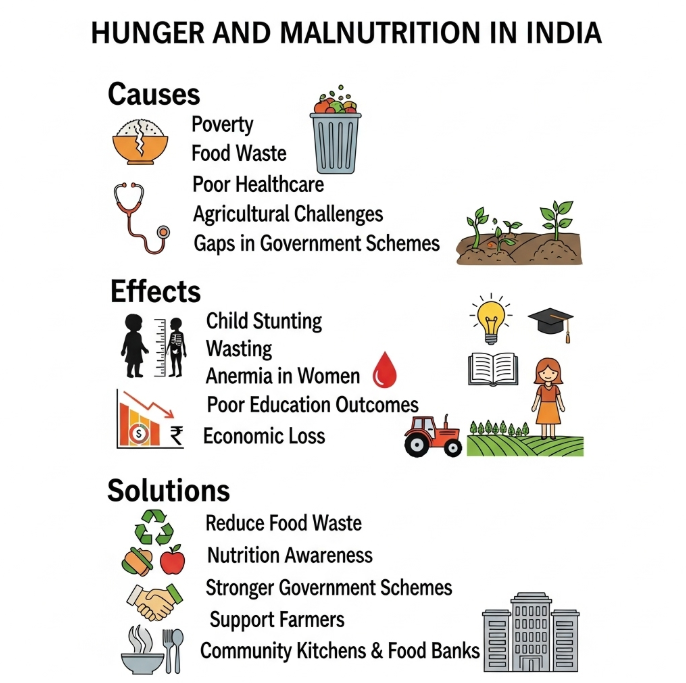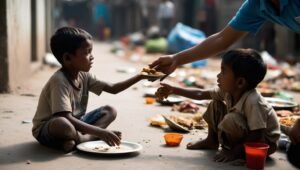Table of Contents
- Hunger and Malnutrition in India: Causes and Solutions
- The Scale of the Problem
- Causes of Hunger and Malnutrition in India
- Impact of Hunger and Malnutrition
- Government Initiatives
- Role of NGOs in Fighting Hunger
- Solutions to Hunger and Malnutrition in India
- Hunger and Malnutrition in India: FAQs
- Q1. What is the difference between hunger and malnutrition?
- Q2. What are the main causes of malnutrition in India?
- Q3. How does hunger affect children?
- Q4. Which government schemes address hunger in India?
- Q5. How can I help reduce hunger in India?
- Conclusion
Hunger and Malnutrition in India: Causes and Solutions
India has made great progress in many areas. Yet, hunger and malnutrition remain some of the biggest challenges the country faces. Millions of children and adults do not get enough food or the right nutrients. This has long-term effects on health, education, and economic growth.
In this blog, we explore the state of hunger and malnutrition in India, its causes, its impact, and how it can be solved.
The Scale of the Problem
India is home to one of the largest populations suffering from hunger and malnutrition. According to the Global Hunger Index 2023, India ranks 111 out of 125 countries (Global Hunger Index).
Some alarming facts:
- Over 190 million Indians go hungry every day.
- 35.5% of children under five are stunted (low height for age).
- 19.3% of children under five are wasted (low weight for height).
- 57% of women aged 15–49 suffer from anemia (NFHS-5).
These numbers highlight how serious hunger and malnutrition in India are.
Causes of Hunger and Malnutrition in India
Several factors contribute to the crisis.
1. Poverty and Inequality
Many families cannot afford nutritious food. Even when food is available, poverty limits access.
2. Food Waste
Every year, India wastes 50–60 million tonnes of food. This is enough to feed millions of hungry people. (Add internal link to your blog: How much food is wasted in India annually?).
3. Poor Healthcare and Sanitation
Malnutrition is not only about food. Lack of clean water, toilets, and healthcare increases infections that make children weaker.
4. Agricultural Challenges
Farmers face problems like low crop prices, lack of storage, and climate change. This affects the supply of affordable food.
5. Gaps in Government Schemes
India has many food programs like the Public Distribution System (PDS), Midday Meal Scheme, and POSHAN Abhiyaan. But gaps in implementation reduce their impact.

Impact of Hunger and Malnutrition
The effects of hunger and malnutrition in India go far beyond empty stomachs.
- On children: Stunted growth, weak immunity, poor school performance.
- On women: Higher risk during pregnancy, anemia, poor health.
- On economy: Malnourished children grow up to be less productive adults. The economy loses billions every year due to reduced workforce efficiency.
A hungry child today means a weaker nation tomorrow.
Government Initiatives
India has taken many steps to fight hunger and malnutrition. Some key programs are:
- Public Distribution System (PDS): Provides subsidized rice, wheat, and grains.
- Integrated Child Development Services (ICDS): Offers food and health services to children and mothers.
- Midday Meal Scheme: Gives hot meals to school children.
- POSHAN Abhiyaan: Aims to reduce stunting, anemia, and malnutrition in children and women.
While these schemes have helped, there is still a long way to go.
Role of NGOs in Fighting Hunger
NGOs play a huge role in bridging the gap. Organizations like Reshine Organisation and others collect surplus food from donors, restaurants, and events. They then distribute it to families, hospitals, and communities in need.
Examples of NGO action:
- Daily food distribution in hospitals and schools.
- Food drives and mobile vans to reach remote villages.
- Nutrition awareness programs for mothers and children.
How much food is wasted in India annually?
Food Donation NGOs in Karnataka: How Reshine Organisation Helps Fight Hunger
Solutions to Hunger and Malnutrition in India
Ending hunger requires collective action. Some possible solutions are:
1. Reduce Food Waste
Encourage households, hotels, and corporates to donate surplus food. NGOs can help in collection and redistribution.
2. Improve Nutrition Awareness
Families need knowledge about balanced diets, breastfeeding, and hygiene. Awareness campaigns can make a big difference.
3. Strengthen Government Schemes
Ensure schemes like PDS and Midday Meals reach every child and family without leakages.
4. Support Farmers
Better storage, fair crop prices, and sustainable farming can improve food availability.
5. Community Participation
Community kitchens, food banks, and local volunteer groups can provide immediate support to the hungry.
Hunger and Malnutrition in India: FAQs
Q1. What is the difference between hunger and malnutrition?
Hunger means not having enough food. Malnutrition means not getting the right nutrients even if food is available.
Q2. What are the main causes of malnutrition in India?
The main causes are poverty, food waste, poor healthcare, low farm income, and weak implementation of food schemes.
Q3. How does hunger affect children?
It leads to stunted growth, weak immunity, poor learning, and lower productivity in adulthood.
Q4. Which government schemes address hunger in India?
Key schemes include PDS, ICDS, Midday Meal Scheme, and POSHAN Abhiyaan.
Q5. How can I help reduce hunger in India?
You can donate to NGOs, reduce food waste at home, volunteer in food drives, and spread awareness.
Conclusion
Hunger and malnutrition in India remain a major challenge. Despite government schemes and economic growth, millions still go hungry. Children and women suffer the most, affecting the future of the country.
The good news is that each of us can help. Donating food, supporting NGOs, and reducing waste are powerful ways to make a difference.
At Reshine Organisation, we work every day to fight hunger by redistributing surplus food and serving meals to those in need. You can join us in this mission.




